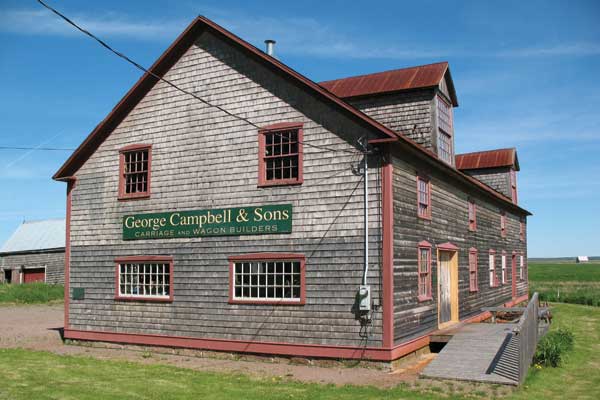Although its carriage and casket business is long gone, the building and stories remain.
Charlie Anderson always knew when something was being built at Campbell Carriage Factory, a half-kilometre across the marsh from his farm in Middle Sackville, NB. The kerosene engine inside would sputter to life, ka-chug four times and let out a loud bang. Then the cycle would repeat itself, over and over.
"I was fascinated by that old engine, the way it carried on," he says, the memory prompting a chuckle. "I could hear it over home every time it hit."
It's a sound Anderson hasn't heard in almost 60 years, not since woodworker George Rogers and blacksmith Jimmy O'Neal, the factory's last employees, finished their final shift. It was the end for a New Brunswick business that built and repaired hundreds of carriages, wagons and sleighs-with a sideline in tools, farm equipment and caskets-over the course of a century, but not for the building itself. It was boarded up and left almost untouched for decades.

When Al Smith, of Tantramar Heritage Trust, stepped inside the building in the late 1990s, it was like opening a time capsule. Tools lay on cluttered benches and patterns hung on wall hooks, ready to tackle jobs that never came. Partially assembled wooden-spoked wheels were scattered among wagons and sleighs brought in for repair, and forgotten.
"It looked like the workmen had put their tools down 50-plus years ago and just left it," recalls Smith, a founder of the community group, dedicated to historical preservation.
More than 6,000 artifacts were catalogued after the Campbell family donated the building to the Trust in 1998. After six years of research and restoration, the factory was opened as a museum, in 2003, transporting visitors to a time when horses and carriages ruled the rough country roads, and the automobile was still called a "horseless carriage."
"Every community of any size had a carriage factory," notes Paul Bogaard, the Trust's president, and a philosophy professor at nearby Mount Allison University. There were at least four others in Sackville and hundreds across the country, but Bogaard is confident this is the last one standing. "In all of Canada, there's not another carriage factory in its original place with its original stuff," he says.
It has taken years of detective work to trace the factory's history, and Bogaard never tires of telling the story. Scottish immigrant Ronald Campbell founded the business in the early 1850s, converting a tannery into a carriage shop. By 1900 it employed a dozen craftsmen and apprentices, producing 60 or more vehicles a year-fancy carriages and sleighs, one-horse sleds called pungs, and ladder-sided wagons to haul hay from the prairie-like Tantramar Marsh, at the factory's doorstep.
"This is pre-industrial… this was not yet a Henry Ford assembly line," says Bogaard. "Every product turned out here was slightly different."
In the early days the factory, like its products, relied on horsepower. An 1870 article in the local paper describes how a circular millwheel at the rear of the factory "set in motion by one or more horses, according to the kind of work," kept the saws and lathes running. The six-horsepower engine Charlie Anderson remembers replaced it in the early 1900s.
The engine is gone, but on a bright day last spring Anderson-still spry in his 90th year-dropped in to explain how a system of belts and rollers powered the machinery, including the planer that relieved George Rogers of several fingers.
"He'd get to planing away and, if he wasn't paying attention, why he'd lose a finger awful quick," Anderson says, his eyes twinkling. "There weren't too many left on one hand."
Stories abound about Rogers, who worked at the factory 66 years. He started as an apprentice when he was a teenager, in 1884, and remained on the payroll until shortly before the factory closed.
Anderson can still see Rogers working at his bench beside a potbellied stove "singing away and whittling, making spokes and so forth." The initials "G.R." painted on a staircase and scratched on a windowpane assert his claim to the factory's woodworking room.
Dick McLeod of Westcock, just outside Sackville, accompanied his father to the factory on "a raw, slushy day" in the winter of 1944 to pick up a new pung. He was 11 and remembers Rogers and O'Neal teasing him about girls as they put the finishing touches on the new sled, transferring bells from the old one.
By then the factory was winding down. The McLeods bought the last pung, for $95.
Just as the automobile eclipsed the carriage, snowplows began to clear rural roads after the Second World War, making sleighs obsolete. McLeod's father bought a truck in 1948, and the pung went into storage.
It's back in the factory and on display in the museum-which has expanded facilities, including an addition made with 200-year-old timbers, replicating what was demolished years ago.
Visitors can trace each stage of production, from machine shop to George Rogers' workbench to upstairs paint room, where fine pinstriping was applied to completed vehicles.
Anderson misses the chugs and bangs that assured neighbours the factory was still in business. "It was nice to see some industry here, but its phase has passed, I guess."
The old engine may be silent, but for the Campbell Carriage Factory a new phase is just beginning.
The Campbell Carriage Factory Museum is open mid June through August. For more information call (506) 536-3079.
